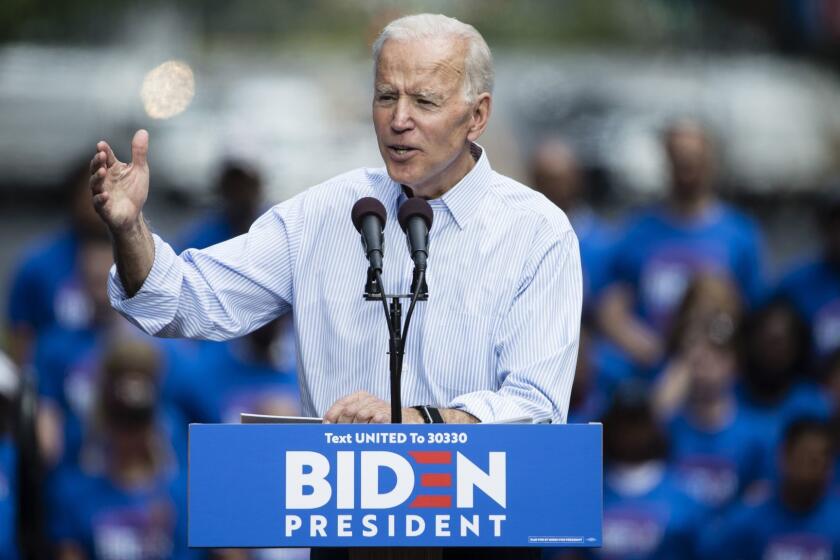Bloomberg releases plan to reduce carbon emissions by 50% in 10 years
- Share via
NEW YORK — Democratic presidential candidate Michael R. Bloomberg on Friday unveiled a broad plan to eliminate all coal power plants and slow the expansion of the natural gas sector as part of a policy to fight climate change that he says would cut carbon emissions across the U.S. economy by 50% over the first 10 years.
The New York billionaire, who has devoted significant time and money toward fighting climate change in recent years, said the new plan is the first of several that would ultimately move the nation toward phasing out fossil fuels completely “as soon as humanly possible” — ideally before 2050.
“The president refuses to lead on climate change, so the rest of us must,” Bloomberg said in a statement accompanying the release of the new policy. He added: “As president, I’ll accelerate our transition to a 100% clean energy economy.”
Climate has emerged as a central issue in both the 2020 Democratic primary election and in Bloomberg’s young candidacy, which he formally launched just three weeks ago. The plan, while a sharp shift away from President Trump’s push to weaken environmental safeguards, is unlikely to win over his party’s loudest environmental activists.
If Joe Biden had been inclined to take a middle-of-the-road approach toward climate change, he’s abandoned it, judging by the proposal he unveiled Tuesday — an aggressive $1.7-trillion, 10-year plan to combat warming that goes considerably further than the environmental agenda of the Obama White House.
It stops well short of the goals of the “Green New Deal,” a sweeping resolution embraced by many on the left — including some of Bloomberg’s presidential rivals — that calls for sourcing all of the nation’s electricity from clean energy in a decade. Bloomberg’s plan envisions “phasing out of all carbon and health-threatening pollution in the electricity sector” to ensure 80% clean electricity by the end of his second term.
The presidential contenders who have signed onto the Green New Deal include Sens. Bernie Sanders of Vermont, Elizabeth Warren of Massachusetts, Cory Booker of New Jersey and Amy Klobuchar of Minnesota.
Bloomberg does not outline a cost for his plan. Campaign officials said he would begin to release cost estimates in the coming weeks as they finalize details. Some of his Democratic opponents have large taxpayer investments associated with their clean energy plans. Sanders, for example, has a $16.3-trillion price tag.
Bernie Sanders releases a $16-trillion Green New Deal plan as he visits fire victims in Paradise, Calif.
The plan doesn’t address nuclear power directly, but campaign spokesman Brian Reich said Bloomberg supports “maintaining a safe, reliable nuclear presence in our energy makeup.” “We should not be retiring existing nuclear plants, nor should we be building new ones when the cost of wind, solar and batteries are declining dramatically,” he said.
Bloomberg’s specific goals include closing the nation’s remaining 251 coal power plants with clean energy by 2030. He says he’ll release another plan in the coming weeks that outlines a policy to help communities impacted by the closures.
It would aim to stop the “rush” to build new gas plants by imposing strict new emissions and health protections, although Bloomberg’s team did not immediately respond to questions about how his policy would specifically impact energy companies’ plans to create 150 new gas plants in the coming years.
It would end all taxpayer subsidies for fossil fuel companies, establish a moratorium on new fossil fuel leases on federal lands, and quadruple the amount of federal dollars dedicated to research and development in clean energy and a clean grid to at least $25 billion each year.
The plan promises to reverse the Trump administration’s rollbacks of clean air, water, health and safety, and waste rules. It also says Bloomberg would prioritize “environmental justice” and “environmental racism” by instructing federal agencies to consider environmental impacts in all actions and creating environmental justice offices in every agency, among other changes.
More to Read
Get the L.A. Times Politics newsletter
Deeply reported insights into legislation, politics and policy from Sacramento, Washington and beyond. In your inbox twice per week.
You may occasionally receive promotional content from the Los Angeles Times.












